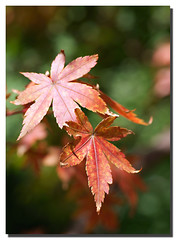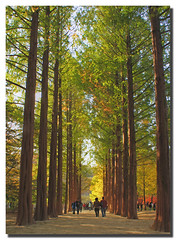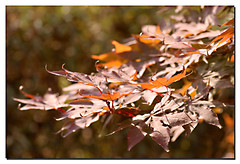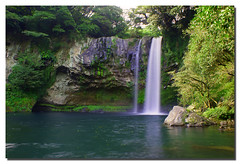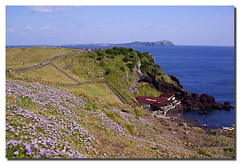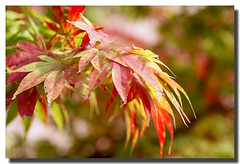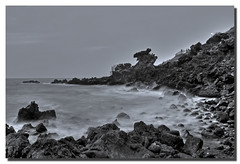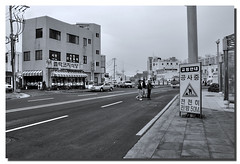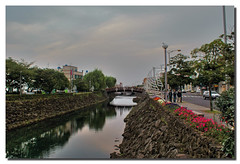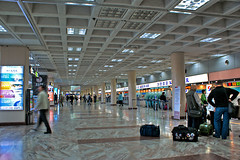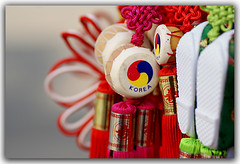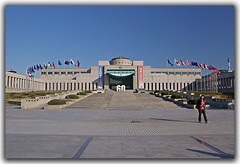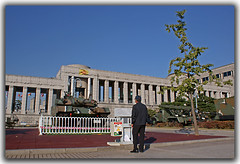

The New Year is an event that happens when a culture celebrates the end of one year and the beginning of the next year. Cultures that measure yearly calendars all have New Year celebrations.[1]
Contents[hide] |
[edit] Western new year
In countries governed by the Gregorian calendar, the celebration of New Year is celebrated on January 1, the date that is considered the most festive of them.

Traditionally, the Roman calendar began the first day of March. However, it was in January (the eleventh month) when the consuls of ancient Rome assumed the government. Julius Caesar, in 47 BC, changed the system, creating the Julian calendar, with some modifications in the time of Marco Antonio consul in 44 BC, the emperor Augustus Caesar in 8 BC and finally by Pope Gregory XIII in 1582, is used today. In this year begins on January 1. Subsequently, the Gregorian calendar had the habit and the celebration was marked with a religious significance during the Middle Ages and later centuries.
With the expansion of Western culture to the rest of the world during the twentieth century, the January 1 date became a universal in nature, even in countries with their own New Year celebrations (e.g., China).
At present, the celebration of New Year is a major event in the world. Major events are held in major cities around the world New Year's Eve (New Year's Eve for the December 31), being accompanied by the largest fireworks events. The largest events in the world are focused on:
 Australia Sydney
Australia Sydney Hong Kong Hong Kong
Hong Kong Hong Kong GBR London
GBR London USA New York
USA New York Brazil Río de Janeiro,São Paulo
Brazil Río de Janeiro,São Paulo Chile Valparaíso
Chile Valparaíso
While in Sydney was launched at midnight over 80,000 fireworks to more than one and a half million attendees, being the most-watched event on television worldwide last year at Valparaiso receive more than two million visitors to witness the largest fireworks in a natural setting and the huge worldwide; a total of more than 21 kilometers of fireworks on the bay, from the commercial port city of Valparaiso to Concon, Chile, all in 25 minutes of entertainment. In New York, the celebration is focused around a big crystal ball that descends on a crowd in Times Square, is also the party with the largest number of attendees last year: more than three million people. Moreover, much of the huge holiday clubs.
In the culture of Latin America there are a variety of traditions and superstitions for these dates as a way of omens for the coming year. The uncorking a bottle of champagne at 0:00 1. January still remains a symbol of New Year's celebration.
The New Year feast is closely related to the celebration of Christmas Eve, Christmas and Hannukah. Due to the closeness between all these parties is that much of the world sees the last week of the year as the beginning of the holiday period, either in winter (in the Northern Hemisphere) or summer (in the Southern Hemisphere).
According to the Christian tradition, on January 1 coincides with the circumcision of Christ (eight days after birth), when the name of Jesus (Luke (II: 21)).
[edit] Modern new year celebrations
The most common modern dates of celebration are listed below, ordered and grouped by their appearance relative to the conventional Western calendar.
Many cities across the world celebrate the New Year. The celebrations usually include a firework's display, and other festivities. London, for example, has a major fireworks display along the River Thames, followed by a parade on New Year's Day.
The Gregorian calendar is now used by many countries as the official calendar. This has meant that celebrations for the New Year have become much larger than before. Some countries even consider 1 January to be a national holiday.
[edit] January
- 1 January: The first official day of the year in the Gregorian calendar used by most countries. Eight of the twelve biggest Eastern Orthodox Churches which have adopted the Revised Julian calendar - Bulgaria, Cyprus, Egypt, Greece, Poland, Romania, Syria and Turkey - also celebrate 1 January as the New Year.
- In the Eastern Orthodox Church, the civil New Year falls on Gregorian 14 January (1 January in the Julian calendar). Many in the countries where Eastern Orthodoxy predominates celebrate both the Gregorian and Julian New Year holidays, with the Gregorian day celebrated as a civic holiday, and the Julian date as the "Old New Year", a religious holiday. The orthodox churches of Georgia, Jerusalem, Russia, the Republic of Macedonia and Serbia still use the Julian Calendar.
- The Chinese New Year, also known as the Lunar New Year, occurs every year on the new moon of the first lunar month, about four to eight weeks before spring (Lichun). The exact date can fall anytime between 21 January and 21 February (inclusive) of the Gregorian Calendar. Each year is symbolized by one of 12 animals and one of five elements, with the combination of animals and elements (or stems) cycling every 60 years. It is the most important Chinese celebration of the year.
- The Vietnamese New Year is the Tết Nguyên Đán which is for most times the same day as the Chinese New Year.
[edit] March
- Nava (new) Varsha (year) is celebrated in India in various regions in March-April.
- Hola Mohalla, New Year's Day in the Sikh Nanakshahi calendar is on 14 March.
- The Iranian New Year, called Nowruz, is the day containing the exact moment of the vernal equinox, commencing the start of the spring season. In 2008 this falls on 20 March.
- The Zoroastrian New Year coincides with the Iranian New Year of Nowruz. It is celebrated by the Parsis in India and by Zoroastrians and Persians across the world.
- In the Bahá'í calendar, the new year occurs on the vernal equinox on 21 March, and is called Naw-Rúz.
- In the Saka Calendar (Balinese-Javanese Calendar) the celebration of new year falls on 30rd of March in this year. the celebration gather of Nyepi, Balinese Hindu holiday.
- The Telugu New Year generally falls in the months of March or April. The people of Andhra Pradesh, India celebrate the advent of Lunar year this day. This day is celebrated across entire Andhra Pradesh as UGADI(Meaning the Start of a new Year.).The first month is Chaitra Masam. Masam means month.
- Kashmiri Calendar, Navreh (New Year): 5083 Saptarshi/2064 Vikrami/2007-08 AD, 19 March.
- Gudi Padwa is celebrated as the first day of the Hindu year by the people of Maharashtra, India. This day falls in March or April and coincides with Ugadi. (see: Deccan)
- The Kannada New Year or Ugadi is celebrated by the people of Karnataka, India as the beginning of a new year according to the Hindu Calendar. The first month of the new Year is Chaitra.
- Sindhi festival of Cheti Chand is celebrated on the same day as Ugadi/Gudi Padwa to mark the celebration of the Sindhi New Year.
- The Thelemic new year on 20 March is usually celebrated with an invocation to Ra-Hoor-Khuit, commemorating the beginning of the New Aeon in 1904. It also marks the start of the twenty two day Thelemic holy season, which ends at the third day of the writing of The Book of the Law. This date is also known as The Feast of the Supreme Ritual. There are some that believe the Thelemic New Year falls on either 19,20,21 March, depending on the Vernal Equinox, this is The Feast for the Equinox of the Gods which is held on the Vernal Equinox of each year to commemorate the founding of Thelema in 1904. In 1904 the Vernal Equinox was on a 21st and it was the day after Aleister Crowley ended his Horus Invocation that brought on the new Æon and thelemic New Year.
[edit] April
- The Assyrian New Year, called Rish Nissanu, occurs on 1 April
- The Nepali new year is celebrated in spring, on the first day of the lunar month Baisakh. In the Gregorian calendar, it usually falls between 12 and 15 April.
- The Thai and Lao New Year are celebrated from 13 to 15 April by splashing water.
- The Cambodian New Year and Lao New Year are celebrated from 13 to 15 April.
- The Bengali New Year Pohela Baisakh is celebrated on 14 or 15 April in a festive manner in both Bangladesh and West Bengal, India.
- The Sinhalese New Year falls In April, celebrated with the harvest festval (the month of Bak) when the sun moves from the Meena Rashiya (House of Pisces) to the Mesha Rashiya (House of Aries) Sri Lankans begin celebrating their National New Year "Aluth Avurudhu" in Sinhala and "Puththandu (புத்தாண்டு)" in Tamil. However, unlike the usual practice where the new year begins at midnight, the National New Year begins at the time determined by the astrologers. Not only the beginning of the new year but the conclusion of the old year is also specified by the astrologers. And unlike the customary ending and beginning of new year, there is a period of a few hours in between the conclusion of the Old Year and the commencement of the New Year , which is called the "nona gathe" (neutral period). During this time one is expected to keep off from all types of work and engage solely in religious activities.
- In India, the Tamil New Year and Vishu are celebrated on the same day respectively in the Southern Indian states of Tamil Nadu and Kerala. They generally fall on 13 or 14 April. The first month of the Tamil New Year is called Chithrai. Every year in the month of Chithrai (சித்திரை), in the temple city of Madurai, the Chithrai Thiruvizha is celebrated in the Meenakshi Temple. A huge exhibition is also held, called Chithrai Porutkaatchi. In some parts of Southern Tamil Nadu, it is also called Chithrai Vishu. The day is marked with a feast in Hindu homes and the entrance to the houses are decorated elaborately with kolams. In some parts of Karnataka, New year may be celebrated on this day, although it is most commonly celebrated on the day of Gudi Padwa, the Maharashtrian new year as well.
- Based on the long history of the tamil language and in consultation with experts, the Tamil Nadu Government (Chief Minister Kalaignar M. Karunanithi) has announced the month of 'Thai' as the first month of tamil year. The Tamil New Year will officially be celebrated in the month of thai (falls usually on 15 January) from this year (2008). This is not based on religion, but on the long tamil culture. The day is also celebrated as 'PONGAL' (harvest festival) in Tamil Nadu. Other states like, Kerala, Andhra Pradesh, Karnataka and Maharashtra celebrate harvest festivals during this month.
[edit] Northern fall
- Rosh Hashanah (Hebrew for 'head of the year') is a holiday commemorating the culmination of the seven days of Creation, and marking God's yearly renewal of His world. The day has elements of festivity and introspection, as God is traditionally believed to be assessing His creation and determining the fate of all men and creatures for the coming year.
- In the Coptic Orthodox Church, the New Year, called Neyrouz, coincides with 11 September in the Gregorian calendar between 1900 and 2099, with the exception of the year before Gregorian leap years, when Neyrouz occurs on 12 September). The Coptic year 1723 began in September 2005. The Ethiopian Orthodox New Year, called Enkutatash, falls on the same date as Neyrouz; the Ethiopian calendar year 1999 thus began on 11 September 2006.
- The Gujarati New Year is usually celebrated the day after the festival of Diwali (which occurs in mid-fall - either October or November, depending on the Lunar calendar). The Gujarati New Year is synonymous with sud ekam of the Kartik month - the first day of the first month of Gujarati lunar calendar. Most other Hindus celebrate the New Year in early spring, but the Gujarati farming community celebrates the New Year after Diwali to mark the beginning of a new fiscal year.
- Some neo-pagans celebrate Samhain (a festival of the ancient Celts, held around 1 November) as a new year's day representing the new cycle of the Wheel of the Year, although they do not use a different calendar that starts on this day.
- The now deceased Murador Aboriginal tribe of Western Australia celebrates New Years on what is known on present day calendars to be the 30th of October. A time of reconciliation and celebration of friendship, the Murador tribe were have said to place great importance on the past as well as the year that was coming[2]
[edit] Variable
- The Islamic New Year occurs on 1 Muharram. Since the Muslim calendar is based on 12 lunar months amounting to about 354 days, the Muslim New Year occurs about eleven days earlier each year in relation to the Gregorian calendar, with two Muslim New Years falling in Gregorian year 2008.
[edit] Christian liturgical year
Since the 17th century, the Roman Catholic ecclesiastic year has started on the first day of Advent, the Sunday nearest to St. Andrew's Day (30 November). According to the Latin Rite of the Catholic Church, the liturgical year begins at 4:00 p.m. on the Saturday preceding the fourth Sunday prior to 25 December. The same liturgical calendar is followed by churches descended from it, including the Anglican and Lutheran Churches.
The Eastern Orthodox Church liturgical calendar begins on 1 September — proceeding annually from the celebration of Jesus' birth in the winter (Christmas), through his death and resurrection in the spring (Pascha / Easter), to his Ascension and the Assumption of his mother (Dormition of the Theotokos / Virgin Mary) in the summer.
[edit] Historical Christian new year dates
The ancient Roman calendar started the year on 1 March, which is still reflected in the names of some months which derive from Latin: September (seven), October (eight), November (nine), December (ten). The year used in dates during the Roman Republic and the Roman Empire was the consular year, which began on the day when consuls first entered office — probably 1 May before 222 BC, 15 March from 222 BC to 154 BC, but this event was moved to 1 January in 153 BC.[3] In 45 BC, Julius Caesar introduced the Julian calendar, which continued to use 1 January as the first day of the new year.
In the Middle Ages in Europe a number of significant feast days in the ecclesiastical calendar of the Roman Catholic Church came to be used as the beginning of the Julian year:
- In Christmas Style dating the new year started on 25 December. This was used in Germany and England until the thirteenth century, and in Spain from the fourteenth to the sixteenth century.
- In Annunciation Style dating the new year started on 25 March, the feast of the Annunciation. This was used in many parts of Europe in the Middle Ages, and was the style introduced by Dionysius Exiguus in AD 525. Annunciation Style continued to be used officially in the Kingdom of Great Britain until 1 January 1752, except Scotland which changed to Circumcision Style dating on 1 January 1600. The rest of Great Britain changed to Circumcision Style on the 1 January preceding the conversion in Great Britain from the Julian calendar to the Gregorian calendar on 3/14 September 1752. The UK tax year still starts on 6 April which is 25 March + 12 days, eleven for the conversion from the Julian to the Gregorian calendar plus a dropped leap day in 1900.
- In Easter Style dating, the new year started on Easter Saturday (or sometimes on Good Friday). This was used in France from the eleventh to the sixteenth century. A disadvantage of this system was that because Easter was a movable feast the same date could occur twice in a year; the two occurrences were distinguished as "before Easter" and "after Easter".
- In Circumcision Style dating, the new year started on 1 January, the Feast of the Circumcision of Christ.
[edit] Adoption of 1 January
It took quite a long time before 1 January again became the universal or standard start of the civil year. The years of adoption of 1 January as the new year are as follows -
| Country | Start year[4][5] |
|---|---|
| Venice | 1522 |
| Sweden | 1529 |
| Holy Roman Empire (Germany) | 1544 |
| Spain, Portugal | 1556 |
| Prussia, Denmark[6] and Norway | 1559 |
| France | 1564 |
| Southern Netherlands[7] | 1576 |
| Lorraine | 1579 |
| Dutch Republic | 1583 |
| Scotland | 1600 |
| Russia | 1700 |
| Tuscany | 1721 |
| Britain and British Empire except Scotland | 1752 |
| Thailand | 1941 |
1 March was the first day of the numbered year in the Republic of Venice until its destruction in 1797, and in Russia from 988 until 1492 (AM 7000). 1 September was used in Russia from 1492 until the adoption of the Christian era in 1700 via a December 1699 decree of Tsar Peter I (previously, Russia had counted years since the creation of the world—Anno Mundi).
Autumnal equinox day (usually 22 September) was "New Year's Day" in the French Republican Calendar, which was in use from 1793 to 1805. This was primidi Vendémiaire, the first day of the first month.
[edit] Time zones
Because of the division of the globe into time zones, the new year moves progressively around the globe as the start of the day ushers in the New Year. The first time zone to usher in the New Year is just west of the International Date Line. At that time the time zone to the east of the Date Line is 23 hours behind, still in the previous day. The central Pacific Ocean island nation of Kiribati claims that its easternmost landmass, uninhabited Caroline Island, is the first to usher in the New Year.[8][9]

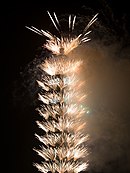

 Chinese New Year
Chinese New Year Matariki - Māori New Year
Matariki - Māori New Year


